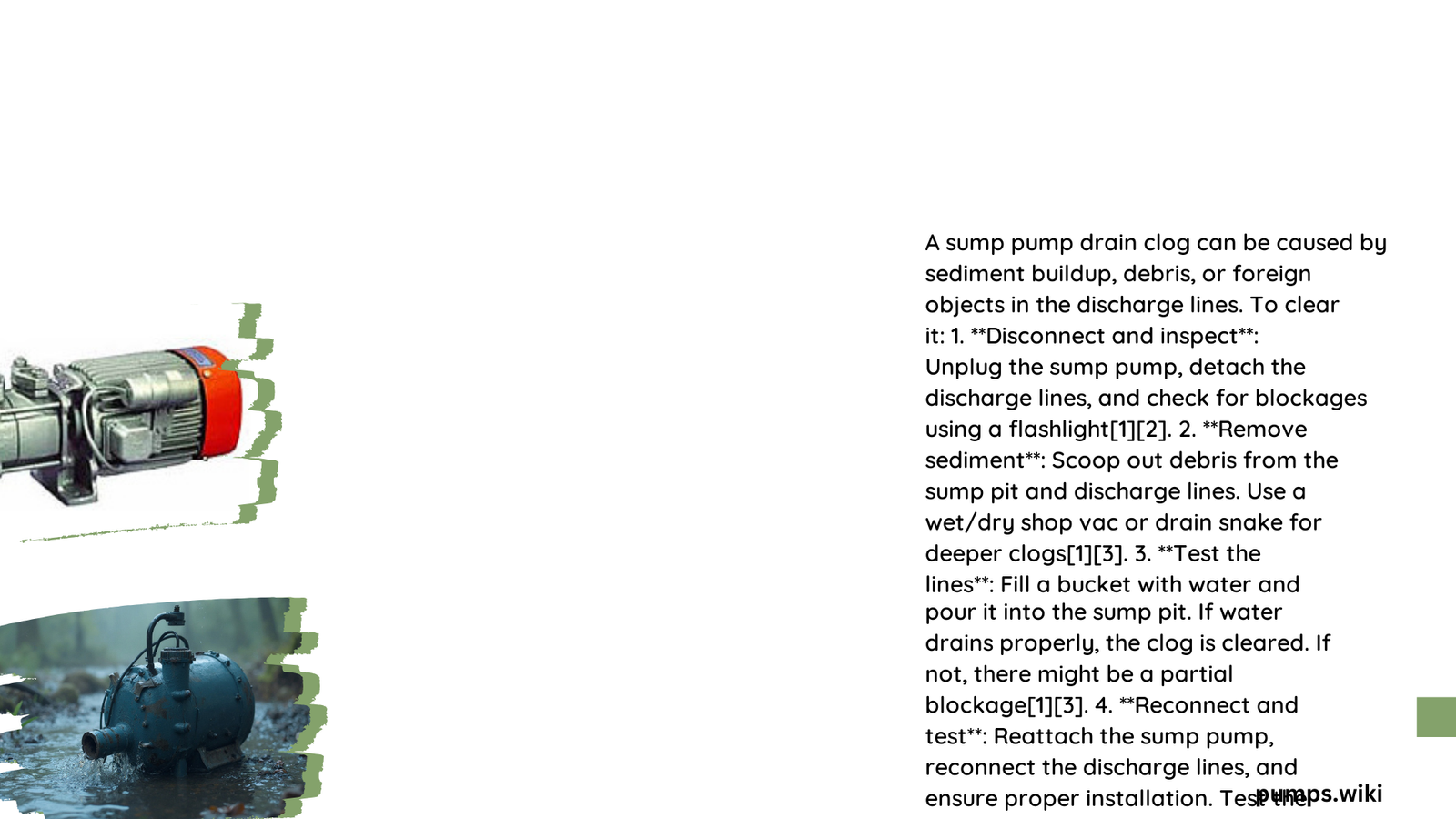Sump pump drain clogs are a common issue that can lead to basement flooding and water damage. These clogs occur when debris, sediment, or other obstructions block the discharge pipe, preventing the pump from effectively removing water from the sump pit. Understanding the causes, solutions, and prevention methods for sump pump drain clogs is crucial for maintaining a dry and safe basement environment.
What Causes a Sump Pump Drain Clog?
Sump pump drain clogs can be caused by various factors:
- Debris accumulation
- Sediment buildup
- Frozen discharge pipes
- Improper installation
- Corrosion in metal pipes
Let’s explore each of these causes in detail:
1. Debris Accumulation
Debris such as leaves, twigs, and small rocks can enter the sump pit and get sucked into the pump, causing a blockage in the discharge pipe. This is often due to:
- An open or improperly sealed sump pit cover
- Outdoor debris entering through the discharge pipe outlet
2. Sediment Buildup
Over time, fine particles of soil, sand, and silt can accumulate in the sump pit and discharge pipe. This gradual buildup can eventually lead to a clog, especially in areas with high mineral content in the groundwater.
3. Frozen Discharge Pipes
In colder climates, water in the discharge pipe can freeze during winter months, creating an ice blockage that prevents water from being pumped out.
4. Improper Installation
If the discharge pipe is not installed with the correct slope or has unnecessary bends, it can lead to water pooling and eventual clogging.
5. Corrosion in Metal Pipes
Older sump pump systems with metal discharge pipes may develop corrosion over time, which can flake off and create blockages.
How Can You Identify a Sump Pump Drain Clog?

Recognizing the signs of a sump pump drain clog is crucial for timely intervention. Here are some indicators:
- The sump pump runs continuously but doesn’t remove water
- Water backs up into the sump pit
- Unusual noises coming from the pump
- Visible water around the base of the sump pump
- Basement flooding during heavy rainfall
What Are the Most Effective Solutions for Sump Pump Drain Clogs?
Addressing a sump pump drain clog promptly is essential to prevent water damage. Here are some effective solutions:
1. Manual Cleaning
Steps:
1. Disconnect the pump from power
2. Remove the pump from the pit
3. Inspect and clean the inlet screen
4. Check and clean the discharge pipe
5. Reassemble and test the system
Tools needed: Screwdriver, pliers, bucket, gloves
Estimated time: 30-60 minutes
2. Using a Plumbing Snake
For clogs further down the discharge pipe:
- Insert the snake into the pipe
- Rotate and push the snake to break up the clog
- Flush the pipe with water to remove debris
Tools needed: Plumbing snake, garden hose
Estimated time: 30-45 minutes
3. Hydro Jetting
For stubborn clogs:
- Hire a professional plumber with hydro jetting equipment
- High-pressure water is used to clear the pipe
Estimated cost: $200-$500
Estimated time: 1-2 hours
4. Thawing Frozen Pipes
For frozen discharge pipes:
- Use a heat tape or pour hot water over the pipe
- Gradually thaw the pipe to avoid damage
Tools needed: Heat tape or hot water
Estimated time: Varies depending on the extent of freezing
How Can You Prevent Future Sump Pump Drain Clogs?
Preventing sump pump drain clogs is more cost-effective than dealing with them after they occur. Here are some preventive measures:
- Regular Maintenance:
- Clean the sump pit and check the pump quarterly
-
Inspect and clean the discharge pipe annually
-
Install a Protective Cover:
-
Use a tight-fitting cover for the sump pit to prevent debris entry
-
Use a Filter or Screen:
-
Install a filter or screen on the pump inlet to catch debris
-
Proper Discharge Pipe Installation:
- Ensure the pipe has a downward slope
- Minimize bends in the pipe
-
Install a check valve to prevent backflow
-
Insulate Discharge Pipes:
-
In cold climates, insulate exposed portions of the discharge pipe
-
Consider a Backup System:
- Install a battery-powered backup pump for added protection
What Are the Long-Term Benefits of Proper Sump Pump Drain Maintenance?
Maintaining a clog-free sump pump drain offers several long-term benefits:
- Reduced Risk of Water Damage:
-
Prevents basement flooding and associated repair costs
-
Extended Pump Lifespan:
-
Reduces strain on the pump, prolonging its operational life
-
Lower Energy Costs:
-
A clog-free system operates more efficiently, consuming less power
-
Improved Indoor Air Quality:
-
Prevents mold and mildew growth caused by excess moisture
-
Increased Property Value:
- A well-maintained drainage system is attractive to potential buyers
Conclusion
Addressing and preventing sump pump drain clogs is crucial for maintaining a dry and safe basement. By understanding the causes, implementing effective solutions, and following preventive measures, homeowners can ensure their sump pump system operates efficiently, providing long-term protection against water damage.
